In many cultures the head is viewed as the most important part of the body, and is therefore to be protected and respected. Its significance derives from the belief, held in many parts of the world, that the head is where the soul or spirit resides. Headdresses are therefore often an important part of daily andceremonial attire because they draw attention to this key body part.
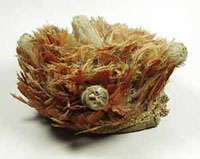
Headdresses made from feathers, however, are not usually part of everyday dress. Feathers are acquired by rearing birds for their feathers, by hunting, or by trade. The production of headdresses is thus often expensive or labour-intensive, and the headdresses themselves are fragile and too delicate for daily use. Feathers are therefore frequently a status-symbol, worn on ceremonial or ritual occasions.
The most striking examples of feather headdresses come from the Amazon area of South America, from Hawaii and Papua New Guinea in the Pacific, and from Africa. The largest collection of headdresses on display in the Museum comes from South America, especially from Guyana.
South America
In South America, feathers have been used to ornament the body since since before the Spanish conquest in the sixteenth century: the brightly-coloured feathers of the macaw, parrot, and toucan are the most popular choices. Each group has individual styles and distinctive ornaments, with their own symbolism and meanings.
Birds
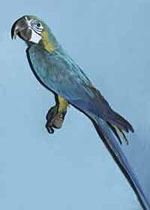
Some birds are hunted for both meat and feathers, whilst others – including parrots,raptors, and carrion eaters – are hunted primarily for feathers and may or may not be eaten or even killed. Often,however, birds are reared for their feathers. The young of some birds are captured, raised in the village, and used as an ongoing source of feathers, which grow back on the birds after being plucked. Birds tamed in this way include parrots, macaws, curassows, guans, toucans, and rheas. Care has to be taken not to overpluck the birds, as this would kill them.
Non-domesticated birds were traditionallly hunted with blow-guns, or with bows and arrows, although shot guns are commonly used today. Blunted arrows are sometimes used so that blood from the bird does not spoil the feathers. Other methods employed are traps baited with seeds, nets, decoys, or torches. Amongst the Achuar-Shiwiar (formerly called Jivaro by European settlers), hunters are very skilled at using bird calls to attract the birds.
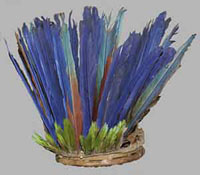
The three most common types of feather used are the macaw, parrot, and toucan. Of these, macaw feathers are most often used in lowland South American featherwork. Macaws are large and brightly coloured – each species’ plumage is composed of at least one striking colour: red, yellow, blue, or green. The long tail feather, up to 40cm, is especially prized for use in headdresses.
The headdress to the right is made of macaw feathers. It belonged to a chief and was collected between 1826 and 1829 in Guyana.
There are of course local variations. In the Chaco area, the roseate spoonbill is common in the area’s large marshes and riverways. Accordingly, its bright pink and red feathers are often used by the local Lengua people to make headdresses, as in the example here which has a band of spoonbill feathers.
Wearing Feathers
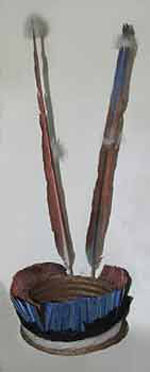
Feathers are worn in South America at initiations, at funeral rituals, by shamans, for social visiting, to express group identity, to mark life stages, or to exercise political power. Feathers are used for these purposes for a number of reasons, not least because of their beautiful bright colours.
Birds are regarded by many South American groups as sacred beings, or as mediators between humans and spirits. They also feature strongly in myths, in which people are often created by birds and taught by them how to behave. By dressing in feathers, the wearer may therefore gain spiritual strength and protection; or indeed they may be able to emulate aspects of the behaviour and appearance of the bird whose feathers they wear. Feathers headdresses are often worn by shamans, demonstrating their connection with birds and bird spirits.
Importantly, feathers are used to mark identity – both the identity of the group, and of individuals within the group. In many areas, headdresses are made and worn by men, with women paying much less attention to their appearance at formal gatherings. Feathers are often seen as a sign of a successful hunter and provider, and by extension as a sign of leadership. Often it is only on initiation into adulthood that a youth is entitled to wear an impressive feather headdress, marking the boy’s new adult status. However, some of the most striking and well-known examples of headdresses come from the Kayapo in Central Brazil, where feathers are worn by women during naming ceremonies.
The headdress pictured above was collected amongst the Akawaio in Guyana. Headdresses such as this were traditionally worn by men at ceremonies, or by the leader of a war party. It is made from macaw feathers and black powis feathers held in a thick cotton band. The two long macaw feathers are decorated with duck down and were worn at the back of the head.
Amongst the Waiwai, men are far more elaborately adorned with feathers than women. Men hunt, and feathers are gained by hunting. A male suitor therefore seeks to impress a potential wife and her family with his skills as a hunter and provider by appearing at a social occasion or ceremony with an impressive array of feathers.
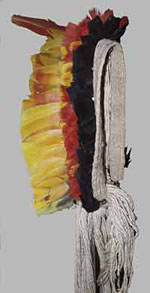
The headdress to the right is part of a Waiwai headdress – it consists of the red-yellow and black sections of the headdress. The white section of eagle feathers is missing. For storage purposes, large headdresses are partially disassembled and are carefully stored in boxes or baskets in the rafters of the house.
The more elaborate headdress is made of macaw feathers. The simpler example consists of a wicker crown covered with toucan, macaw, and hummingbird feathers.





